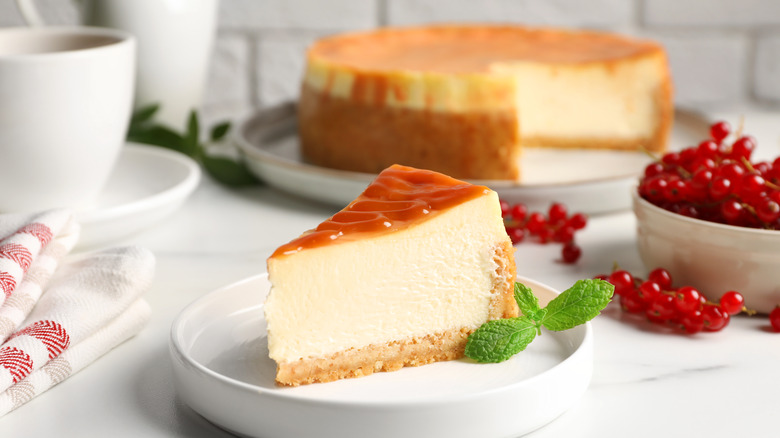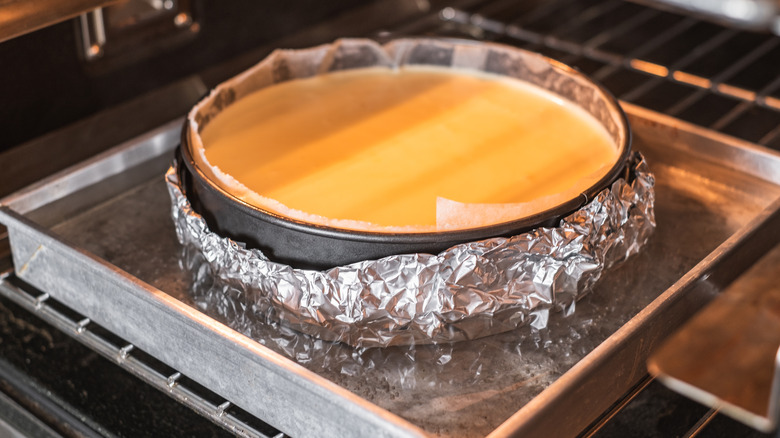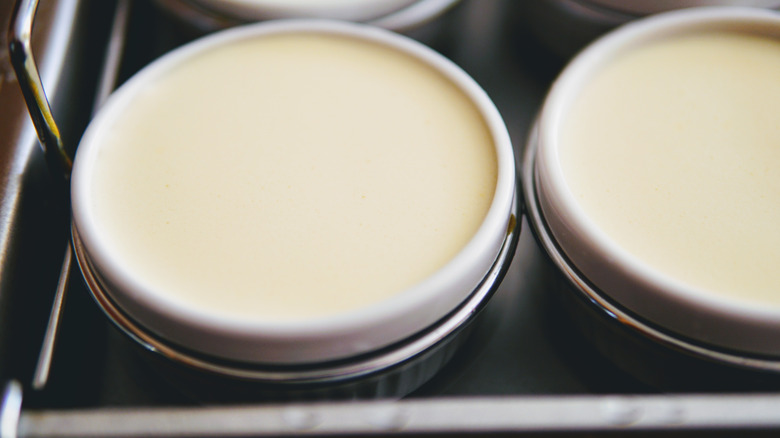How A Water Bath Works To Cook Your Cheesecake
Creamy delicious cheesecake, one of America's classic desserts, is pretty simple to make: Just pre-bake a graham cracker crust, then pour in the cream cheese mixture and bake. But oh, there's the water bath. This is arguably the most intimidating part about making cheesecake for most home cooks. If you've ever wondered how that small pool of water in the oven works to cook your dessert, wonder no more.
A water bath is simply a cooking technique where you have a large pan partway filled with hot water, and the baking dish carrying the batter is placed inside. This setup creates a regulated cooking environment for the cheesecake by allowing equal distribution of heat around the bake. As a result, every part of your creamy dessert cooks at the same temperature (which is hard to achieve with direct heat from the oven) resulting in an evenly baked dish and a beautiful even rise. The water bath also causes a gentle cooking process, which is ideal for this delicate dish because it results in a creamier texture.
Additionally, as the steam from the hot water fills the oven cavity, it creates a highly moist environment that prevents the cheesecake from drying out on top and cracking as it cooks (which is what happens if you don't use a water bath). You can, therefore, look forward to pulling out a perfectly smooth and moist cheesecake from the oven.
Make a water bath for your cheesecake
To make a water bath for your cheesecake, all you need is a baking tin that'll hold the batter (a springform pan is ideal), a larger oven-safe dish that'll carry the water (a roasting pan works great here), aluminum foil, and boiling water. After pre-baking your crust, as you're waiting for it to cool, this is when you start working on the water bath. Begin by boiling water on the stovetop while you mix your filling ingredients, then add the filling to the crust in the springform pan. Wrap this pan with two layers of aluminum foil to prevent water from leaking into your cheesecake and place it inside the roasting pan. Next, place the roasting pan in the pre-heated oven and carefully pour in the hot water to about 1-inch height. Shut the oven door and allow your dessert to bake.
If you find this setup too cumbersome, there's an easier alternative that doesn't involve baking the cheesecake in water. Simply position the springform pan on the middle rack by itself, and place a baking pan with the hot water on the bottom rack. Whichever setup you choose, once your baked good is ready, turn off the oven, crack open the door, and leave the cheesecake inside to cool for about an hour.
Other uses of a water bath in cooking
You've probably heard about a water bath before, even if it wasn't concerning cheesecakes. That's because this technique is applied in several other cooking processes in the kitchen. Also known as a bain-marie, the water bath is common in baking procedures. For instance, a sponge cake benefits from the humid environment created by a water bath. Some cooks also rely on this technique in bread making to produce a moist loaf with a soft crust.
Other popular baked desserts, such as flan, crème brûlée, and similar delicate custards also call for that regulated, gentle, and moist baking environment to ensure they set without cracking. The water bath is also one of the reasons these creamy desserts acquire their signature silky smooth texture.
Beyond desserts, water baths also play a critical role in cooking some savory dishes. Take for example terrines. This tightly packed dish, typically consisting of a mixture of meats, fish, and other ingredients, excels in the humid environment created by a bain-marie which maintains a moist and tender consistency. Additionally, sous vide cooking is a kind of water bath cooking technique where the food is vacuum-sealed and submerged in water that's maintained at a specific temperature. In this case, the goal is to lock in flavors and moisture to produce a tender dish.


